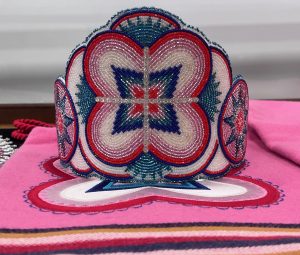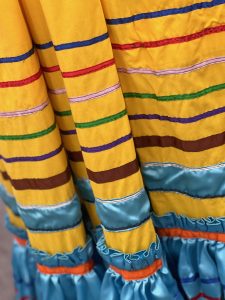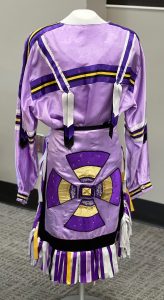
First celebrated in 1990, Native American Heritage Month (NAHM) is a time to recognize the significant contributions the first Americans made to the establishment and growth of the United States. Decades in the making, it is a month dedicated to celebrating the diverse cultures, rich histories, and important contributions of the nation’s first people.
The Gorgas House Museum, in partnership with the Alabama Museum of Natural History, Moundville Archaeological Park, The Fashion Archive, The University of Alabama’s Intercultural Diversity Center, worked with tribal artisans of the Choctaw Nation of Oklahoma, the Cherokee Nation of Oklahoma, and the Louisiana Coushatta of Alabama, to create Cultures, Not Costumes.
This exhibit, currently showcased in the Intercultural Diversity Center (located inside The University of Alabama’s Student Center), provides a brief history of Southeastern Native Americans with historic and modern examples of regalia, such as clothing, adornments, and jewelry. It demonstrates that these pieces are reflections of cultural traditions that span centuries and are more than fashion statements.

The history of Alabama’s first people begins more than 11,000 years ago in an era called the Paleoindian period. Paleoindians lived in a cooler environment and moved across the landscape in small bands hunting megafauna including mammoths, mastodons, and bison. The Archaic period followed and lasted roughly 7,000 years. Changes to the climate and wildlife saw Native Americans hunt smaller game and gather naturally occurring edible plants. After this came a time referred to by archaeologists as the Woodland period that lasted from about 1000 BC to 1000 AD. Populations grew and cultures became increasingly complex with people adopting horticulture, the bow and arrow, pottery-making, and complex funerary ceremonies. The construction of large earthworks, including the mounds found at Moundville Archaeological Park, is a hallmark of the Mississippian period (AD 1000-1550) in Alabama. Mississippian people lived in fortified towns, they grew corn, squash, and beans, and shared similar rituals and symbols.

By the time European explorers and colonialists arrived in the sixteenth century, the Native Americans of Alabama merged into the distinct cultural groups known from the historic period. These included larger groups such as the Cherokees, Chickasaws, Choctaws, and Creeks and smaller cultural groups such as the Alabama-Coushattas and Yuchis. As time progressed and more Europeans, and later U.S., settlers moved throughout the Southeast, these peoples met with continual assaults on their land, warfare, the spread of non-native diseases, and resource exploitation. Between the 1830s and 1850s, the majority of Native Americans in Alabama were forcibly removed from their land to allow for European American expansion.
Despite their nineteenth-century removal, the first peoples of Alabama still exist and have a presence in Alabama. Today, the Poarch Band of Creek Indians and MOWA Band of Choctaw Indians maintain their traditions on portions of the tribal homelands in the state. Other tribal groups, including the Muskogee Creek, Choctaw, Chickasaw, and Cherokee, preserve and maintain connections to their ancestral lands in Alabama. They work together, and with different institutions, including The University of Alabama, to highlight their histories and continue to contribute to the rich cultural heritage of the state and nation.
– Written by Brandon Thompson, Director of the Gorgas House Museum